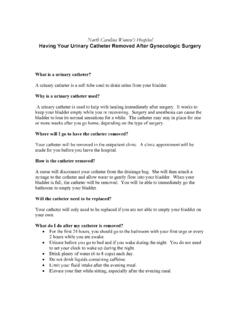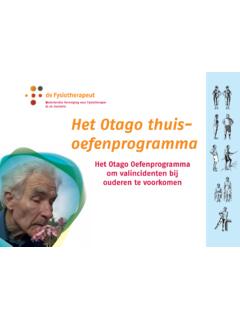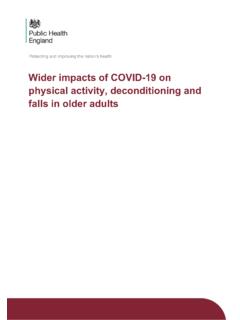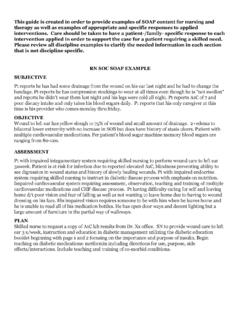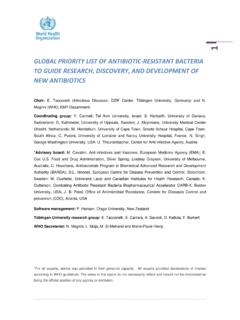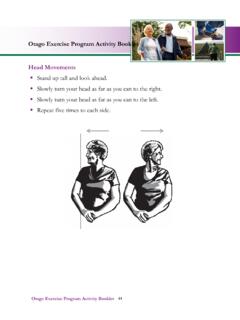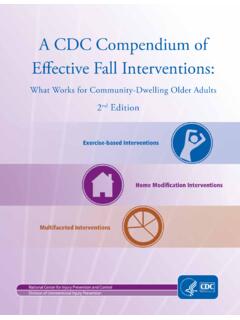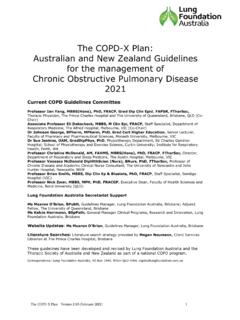Transcription of Reference herein to any specific commercial products ...
1 1 Disclaimer Reference herein to any specific commercial products , programs , or services by trade name, trademark, manufacturer, or otherwise, does not necessarily constitute or imply its endorsement, recommendation, or favoring by the United States Government. The views and opinions expressed are those of the authors and do not necessarily represent the official views of the Government or the Centers for Disease Control and Prevention, and shall not be used for advertising or product endorsement purposes. i Table of Contents Table of Contents .. i Introduction .. 1 Overview of the otago exercise Program .. 2 Background on Older Adult Falls .. 2 Main Features of the otago exercise Program .. 5 Practical Implications of otago Research .. 6 Referral to and Billing for 11 What is otago and how do I refer my patients? A guide for physicians .. 11 How do I get reimbursed for otago ?
2 A guide for physical therapists .. 13 How do I code for otago ? An evolving guide .. 15 What do I do after the final visit? .. 15 Practitioners Toolkit .. 16 Guide to Program Implementation .. 16 Strength, Balance, and Walking Assessments .. 18 Levels and Number of Repetitions for the Exercises .. 27 otago Visit Chart .. 29 Evaluation Forms .. 35 Participants Packet .. 40 Welcome to otago ! .. 41 Key Resources .. 88 References Cited .. 88 Additional Resources .. 90 1 Introduction The otago exercise Program ( otago ) is an individually tailored, home-based, balance and strength fall prevention program that is delivered by a physical therapist over the course of 52 weeks. otago began in New Zealand and was developed, tested, and demonstrated to be most effective for reducing falls and fall-related injuries among high risk individuals: adults more than 80 years of age and those who have had a previous fall within one calendar otago also increased the percentage of older adults who were able to live independently in their The program was developed by Professors John Campbell, MD, FRACP, and Clare Robertson, PhD, researchers at the University of otago in Dunedin, New Zealand and the New Zealand Falls Prevention Research Group, in response to the frequency and severity of fall injuries among older adults in New The Centers for Disease Control and Prevention s (CDC), National Center for Injury Prevention and Control (NCIPC) modified and adapted the New Zealand otago exercise Program manual for use in the United States.
3 NCIPC focuses on preventing injuries,2 including those from falls among older adults through research, program implementation, and evaluation. With permission from the original developers of otago , Professors John Campbell and Clare Robertson, NCIPC adapted the contents of the otago exercise Program manual for implementation at the state and local levels in accordance with Medicare and third party payor rules and regulations. Primary care providers and physical therapists in the United States can work with qualifying older adultsi to develop a personalized otago plan. This manual provides key information to successfully implement the otago exercise Program. i Refer to the Referral to and Billing for otago section in this manual to find out how to qualify to participate in the otago program. 2 Overview of the otago exercise Program Background on Older Adult Falls This section provides implementers with background information about the problem of older adult falls and about the otago exercise Public Health Burden in the United States Falls occur frequently among older adults.
4 More than 30 percent of people aged 65 and older who live in the community fall each year. The incidence increases to 50 percent for those aged 80 and , 4 Two-thirds of those who fall will do so again within 6 Twenty to thirty percent of those who fall suffer moderate to severe injuries that make it difficult to get around or to live independently, which increases their risk of early Older adults who fall are more likely to move into long-term care. Falls are the leading cause of injury, deaths, and hospital admissions for traumatic injuries among people aged 65 and , 4 In 2009, approximately two million older adults were treated in hospital emergency departments for fall injuries and 581,711 were hospitalized after being Data from 2007 show that 18,334 older adults died from injuries related to unintentional Cost of Falls In 2000, the total direct medical costs of fall injuries for people aged 65 and older was $ billion or $ billion in 2010 dollars.
5 Two-thirds of these were hospital By 2020, the annual direct and indirect cost of fall-related injuries for people aged 65 and older is expected to reach almost $55 billion (in 2007 dollars), $ billion of which will be covered by , 7 An observational study of 1,017 seniors published in 1996 established the effects of fall severity on total annual health care Older adults having one fall without serious injury during the course of one year incurred an additional annual cost of about $3,500 (in 2010 dollars) compared with those who did not fall. Having two or more falls without serious injuries increased costs by about $16,500. 3 Having one or more falls that involved at least one serious injury increased health care costs by about $27,000. Evidence-based Fall Prevention programs Research has shown that fall prevention programs for high-risk older adults can produce a net-cost savings of almost nine dollars for each dollar programs designed to prevent falls can: 1) save hospital admission and long-term care costs; 2) help older adults living in communities maintain their independence; and 3) help older adults increase their leg strength and improve their A fall prevention meta-analysis showed that exercise programs that included at least 50 hours of exercise and that challenged balance were associated with significant reductions in fall Background on otago otago is a muscle strengthening and balance retraining program delivered at home by a physical therapist with otago training through a minimum of seven home visits as well as monthly phone calls when there is not a home visit over the course of a year.
6 otago was developed and tested by the New Zealand Falls Prevention Research Group in New Zealand. otago is one of a few fall prevention programs that improves strength and balance and reduces falls and fall related injuries among older adults. Other interventions that address falls, some of which are funded by CDC, can be found in A CDC Compendium of Effective Fall Interventions: What Works for Community-Dwelling Older Adults, 2nd Edition, 2010. Return on Investment The otago exercise Program delivered to persons aged 80 and older delivered a return of $.70 per every dollar 4 The Four otago Trials otago was tested through four randomized controlled trials. A total of 1,016 men and women aged 65 to 97 participated in these otago Trial Results Trial (Time Period) Participants Results Trial One (Two Years; 1992-1994) Women 80 years and older Risk of falling for otago participants was 32 percent lower than for the control group.
7 After one year, the risk of a fall injury for otago participants was 39 percent lower compared with people who received social Trial Two (44 Weeks; 1996) Men and women 65 years and older regularly taking sleep medication Falls among people who stopped taking sleeping medication decreased 66 percent compared with those who continued taking their medication. However, 47 percent of patients who stopped taking medication started again one month after the trial ended. The otago program did not decrease falls in this younger Trial Three (One Year; 1998-1999) Men and women 75 years and older After one year, falls in the otago group were reduced by 46 percent compared with the group that received usual care. Falls were significantly reduced among patients aged 80 years and older. After one year, otago participants had fewer serious fall injuries ( , fractures, hospital admissions, or stitches) compared to the control Trial Four (One Year; 1998-1999) Men and women 80 years and older After one year, falls in the otago group were reduced by 30 percent and fall injuries were reduced by 28 percent.
8 Seventy percent of otago participants were still exercising after one year, and 43 percent exercised each week as Trial Results Summary and Lessons Learned The otago exercise Program can reduce falls and fall related injuries. The program was most effective for adults 80 years and older. Men and women benefited equally. Participants strength and balance improved markedly as assessed by the Chair Stand and the Four-Stage Balance tests. While older adults with and without previous falls benefited equally, if resources are limited, first offer the otago program to adults 80 years and older,1 as otago was shown to be particularly effective in reducing falls and injuries among individuals in that age group. 5 Main Features of the otago exercise Program The chart below gives implementers an overview of how the otago exercise Program works. It describes the assessments, activities, intensity, progressions, frequency, length of exercise sessions, and duration of the strengthening and balance exercises and walking otago Main Features Strengthening Balance Retraining Walking Assessment 30 Second Chair Stand Test11 Four-Stage Balance Test12, 13 Timed Up & Go14-16 Activity Five leg muscle strengthening exercises Four levels of difficulty Twelve balance retraining exercises Four levels of difficulty Not all exercises may be prescribed Advice about walking (see Walking Tips)
9 Intensity Moderate Challenge 8-10 repetitions before fatigue Moderate Challenge Each exercise at a level that the patient can safely perform unsupervised Usual pace with usual walking aid Progressions Increase from one to two sets Increase amount of ankle weight after 2 sets of 10 Supported exercise to unsupported exercise Walk indoors Advance to walking outdoors when strength and balance have improved Length of exercise Sessions Approximately thirty minutes total for exercises; Exercises can be divided up over the day Thirty minutes; can be split into three ten-minute walks throughout the day Frequency Three times a week with rest day between At least three times a week At least twice a week Duration 52 weeks 6 Practical Implications of otago Research This section gives implementers general information about instructor training, program prescription and implementation, and audience selection.
10 Information in this section provides points to consider when implementing the The research reported in this manual adds to the growing body of evidence that falls and resulting injuries can be reduced. Since older people who fall are more likely to require long-term care, preventing falls will help older people living in the community maintain their independence. Fall prevention programs have the potential to reduce hospital admission and long-term care costs, the major costs associated with fall injuries. Unfortunately, many fall prevention programs are implemented in communities without regard to evidence of effectiveness. Not all interventions are effective in reducing falls and otago has been tested in four controlled trials and shown to reduce falls and injuries in older people living at home, particularly in those 80 years of age and older. otago has only been implemented on an individual basis in home settings.




